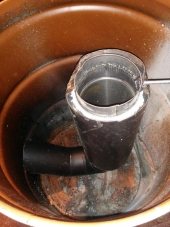
 5
5




Become extra-civilized!
 7
7




best regards, Byron
 2
2




Become extra-civilized!
 2
2




Become extra-civilized!
 6
6




 4
4




 5
5




Become extra-civilized!

 7
7




For all your Montana Masonry Heater parts (also known as) Rocket Mass heater parts.
Visit me at
dragontechrmh.com Once you go brick you will never go back!
 2
2




thomas rubino wrote:Good choice Coydon;
J tubes are easy and inexpensive to build, a good starting point.
If you build an 8" J tube with a piped mass, then you can easily upgrade to a 6" batch when you are ready.
When using a piped mass you need 8" pipes to support the output of a 6" batch.
As far as using pea gravel as your mass.
It works but is a very poor mass compared to using larger heavy dense rock.
In an insulated home, it does the job just fine.
In a yurt, I would want as much solid mass as I could lift into my containment box.
Use dirt /clay but not sand as a filler, you want as many heavy rocks in your containment as you can fit.
You want that mass to keep radiating all night,
Become extra-civilized!




 6
6




For all your Montana Masonry Heater parts (also known as) Rocket Mass heater parts.
Visit me at
dragontechrmh.com Once you go brick you will never go back!
 2
2




thomas rubino wrote:Hi Coydon;
Yes, a packed dirt fill will outperform an air gap-filled tiny rock mass.
Use packed dirt around your tubes and as much heavy dense rock as you have.
Leave no air pockets anywhere.
Leave the pea gravel out.
Become extra-civilized!




 8
8




For all your Montana Masonry Heater parts (also known as) Rocket Mass heater parts.
Visit me at
dragontechrmh.com Once you go brick you will never go back!
 4
4




thomas rubino wrote:Hi Coydon;
Yes, I have heard the soil there is just sand and rocks.
Using your sod to divert water around your foundation is a good use for it.
If you like the fast easy method of pea gravel, then try it out.
It may work out just fine for you.
If you find it a bit chilly in the mornings you can try a solid fill next year.
Become extra-civilized!
 3
3




I noticed that at the lab they just redid the red cabin with cob around the ducts, but then put pea gravel around the outside of that to protect the wooden containment box from excess heat.thomas rubino wrote:Hi Coydon;
Yes, a packed dirt fill will outperform an air gap-filled tiny rock mass.
Use packed dirt around your tubes and as much heavy dense rock as you have.
Leave no air pockets anywhere.
Leave the pea gravel out.
Become extra-civilized!




 5
5




For all your Montana Masonry Heater parts (also known as) Rocket Mass heater parts.
Visit me at
dragontechrmh.com Once you go brick you will never go back!
 2
2




Become extra-civilized!




 6
6




For all your Montana Masonry Heater parts (also known as) Rocket Mass heater parts.
Visit me at
dragontechrmh.com Once you go brick you will never go back!
 5
5




Become extra-civilized!




 4
4




For all your Montana Masonry Heater parts (also known as) Rocket Mass heater parts.
Visit me at
dragontechrmh.com Once you go brick you will never go back!
 3
3




Become extra-civilized!
 3
3




thomas rubino wrote:Hi Coydon;
I think at 18" turning the bricks should provide enough stability but would take more bricks.
However, I suggest when you think about mortar, forget concrete... Dry bagged clay from a pottery place (fire clay is not needed) and clean consistent sand (home Depot builders sand)
Clay mortar is fun to work with and for this application should provide enough stability to contain your mass.
When you wish to remove this, simply tap bricks with a mallet, scrape the mortar into a bucket (very easy) add water to bucket and rehydrate your mortar...
Use the same mortar time and time again.
Become extra-civilized!




 5
5




For all your Montana Masonry Heater parts (also known as) Rocket Mass heater parts.
Visit me at
dragontechrmh.com Once you go brick you will never go back!
 2
2




Become extra-civilized!




 3
3




For all your Montana Masonry Heater parts (also known as) Rocket Mass heater parts.
Visit me at
dragontechrmh.com Once you go brick you will never go back!
 3
3




Become extra-civilized!




 4
4




For all your Montana Masonry Heater parts (also known as) Rocket Mass heater parts.
Visit me at
dragontechrmh.com Once you go brick you will never go back!
 3
3




Become extra-civilized!




 4
4




For all your Montana Masonry Heater parts (also known as) Rocket Mass heater parts.
Visit me at
dragontechrmh.com Once you go brick you will never go back!

|
The glass is neither half full or half empty. It is too big. But this tiny ad is just right:
Learn Permaculture through a little hard work
https://wheaton-labs.com/bootcamp
|



